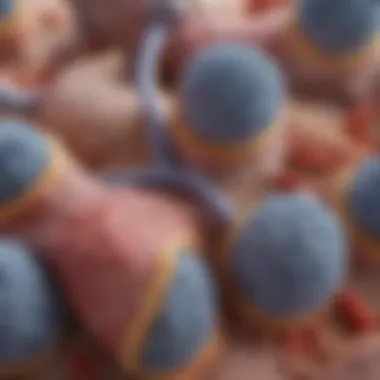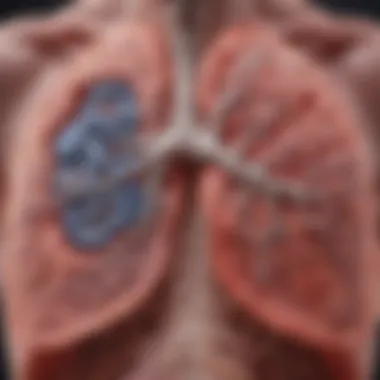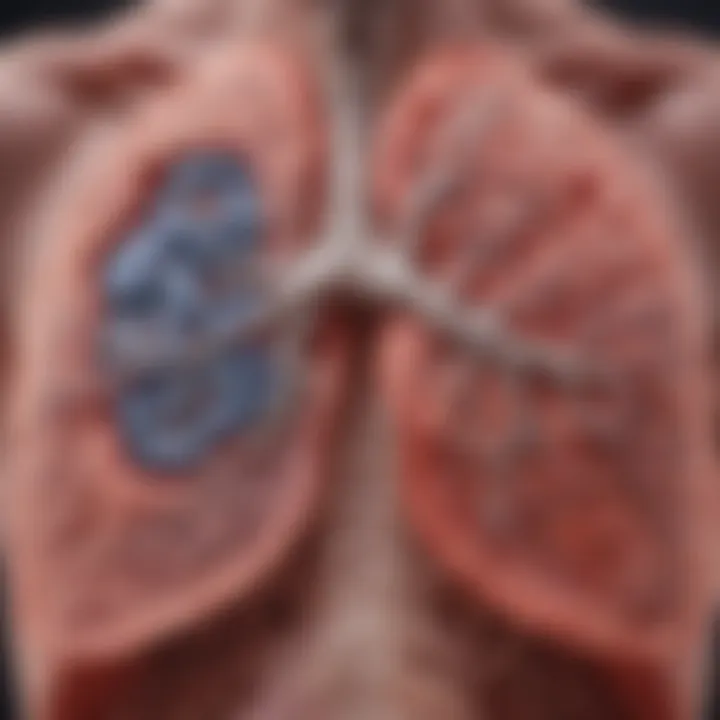Pathophysiology of Community-Acquired Pneumonia


Research Overview
Community-acquired pneumonia (CAP) is a significant health issue affecting populations globally. Understanding its pathophysiology is essential for developing effective treatments and prevention strategies. This section aims to summarize the key findings related to the mechanisms driving CAP, its impact on the immune system, and the resulting clinical features.
Summary of Key Findings
CAP is primarily caused by various pathogens, including bacteria, viruses, and, less commonly, fungi. The most frequent bacterium involved is Streptococcus pneumoniae. The disease often arises from organisms that inhabit the upper respiratory tract and are aspirated into the lungs.
Upon infection, the body’s immune response is activated. The immune system attempts to eradicate the pathogens through both innate and adaptive mechanisms. During this process, inflammation occurs in the lung tissue, leading to symptoms such as cough, chest pain, and difficulty breathing. In severe cases, this can progress to respiratory failure.
Relevance to Current Scientific Discussions
Recent studies have emphasized the importance of host factors in the pathophysiology of CAP. Factors such as age, immunocompetence, and preexisting lung conditions significantly influence susceptibility to pneumonia. Furthermore, the role of biofilms in chronic lung infections has been increasingly recognized, sparking new research avenues in understanding CAP.
Methodology
Research Design and Approach
The examination of CAP's pathophysiology involves a combination of clinical observations, laboratory studies, and population-based research. Studies often use a longitudinal approach to observe the progression of the disease and the effectiveness of various treatments over time.
Data Collection and Analysis Techniques
Data related to the incidence and outcomes of CAP is collected through hospital records, surveys, and clinical trials. Advanced statistical techniques are then utilized to analyze these data sets. Furthermore, biomarkers found in blood and respiratory samples are explored to assess the immune response and severity of the infection. This information helps refine treatment protocols and enhance preventive strategies.
Foreword to Community-Acquired Pneumonia
The examination of community-acquired pneumonia (CAP) is crucial for both clinical practitioners and researchers. CAP remains a significant health issue worldwide, necessitating a deeper understanding of its pathophysiological underpinnings. Understanding CAP encompasses a range of important factors, including its causes, mechanisms, and consequences across diverse populations. This section will detail the definition and significance of CAP and its global prevalence and impact.
Definition and Significance
Community-acquired pneumonia is defined as pneumonia acquired outside of hospital settings. It typically arises from a variety of pathogens including bacteria, viruses, and fungi. The importance of differentiating CAP from hospital-acquired pneumonia lies in its distinct pathogen profiles and treatment approaches. While healthy individuals may experience mild forms, CAP can also lead to severe health complications, especially in vulnerable populations such as the elderly and those with comorbidities.
The impact of CAP on public health is vast. It is a leading cause of morbidity and mortality globally, reflecting substantial health resource utilization. Recognizing the significance of CAP also involves understanding the socio-economic burden it imposes, affecting both individuals and healthcare systems. Treatment requires timely diagnosis and management, which can drastically alter outcomes.
Global Prevalence and Impact
Globally, CAP affects millions each year. Recent estimates indicate that there are approximately 150 million cases of pneumonia annually, with a significant proportion classified as community-acquired. The prevalence of CAP varies by region, age, and other demographic factors. For instance, developing countries report higher rates of severe pneumonia due to factors such as crowded living conditions and limited access to healthcare.
The impact of CAP extends to various sectors. In high-income nations, it is a leading cause of hospital admissions, often requiring intensive care for severe cases. In lower-income countries, the issue is compounded by inadequate vaccination coverage and health infrastructure. Mortality rates from CAP can be notably high, particularly among older adults, children, and immunocompromised individuals.
The understanding of CAP's prevalence is integral for public health interventions, informing strategies aimed at prevention and control.
In summary, the exploration of community-acquired pneumonia goes beyond mere definition; it encompasses understanding its significant global impact and the critical importance of addressing this condition through education and research. A comprehensive grasp of these elements will help illuminate the subsequent sections focused on the etiological agents, pathophysiological mechanisms, and clinical implications of CAP.
Etiological Agents of CAP
Understanding the etiological agents of community-acquired pneumonia (CAP) is crucial for grasping its complexity and variety. This section elaborates on the distinctions in bacterial, viral, and fungal causes, which play significant roles in the disease pathology. Knowledge of these agents aids in both the diagnosis and treatment protocols, ultimately contributing to improved patient management and outcomes.
Bacterial Causes
Bacterial pathogens are the predominant cause of community-acquired pneumonia. Common bacteria responsible include Streptococcus pneumoniae, Haemophilus influenzae, and Mycoplasma pneumoniae. These microorganisms can invade the lung parenchyma, leading to pneumonia through various mechanisms.
- Streptococcus pneumoniae:
- Haemophilus influenzae:
- Mycoplasma pneumoniae:
- It is the most common bacterial cause, especially in adults.
- This encapsulated organism can survive in the alveolar spaces, provoking a strong inflammatory response.
- While less common, it can be significant, particularly in individuals with underlying health conditions.
- Its virulence is increased in patients with chronic obstructive pulmonary disease (COPD).
- This atypical pathogen is often seen in younger populations, causing mild to moderate disease.
- It can evade the immune response, leading to chronic symptoms.
Recognizing these bacterial causes allows clinicians to tailor antibiotic treatment effectively, boosting recovery rates and reducing complications.
Viral Contributors
Viruses also significantly contribute to community-acquired pneumonia, particularly in specific age groups. The most commonly implicated viruses include the influenza virus, respiratory syncytial virus (RSV), and coronaviruses.
- Influenza Virus:
- RSV:
- Coronaviruses:
- Seasonal outbreaks of influenza can lead to secondary bacterial infections, complicating the clinical picture.
- Infections can lead to severe outcomes, especially in the elderly and immunocompromised persons.
- It is primarily associated with pediatric cases but can also affect adults with varying severity.
- RSV can lead to pneumonia by damaging the respiratory epithelium and impairing the immune response.


- Recent strains, notably SARS-CoV-2, highlight the evolving landscape of viral causes of pneumonia.
- These infections may lead to substantial morbidity and pose significant challenges in management.
Knowing the viral agents can assist healthcare providers in diagnosing CAP and implementing appropriate preventive measures, such as vaccines.
Fungal Infections
Fungal infections are a less common but increasingly recognized cause of pneumonia. Pneumocystis jirovecii and fungi like Aspergillus species are notable contributors.
- Pneumocystis jirovecii:
- Aspergillus Species:
- This organism is primarily associated with immunocompromised individuals, notably those with HIV/AIDS.
- The pneumonia caused by Pneumocystis is often severe and can result in mortality if not treated promptly.
- Occasionally, they may cause invasive pulmonary aspergillosis, particularly in patients with underlying lung disease or neutropenia.
- The awareness of fungal causes now plays an important role in the clinical decision-making process in vulnerable populations.
In summary, the diversity of etiological agents in CAP necessitates a thorough understanding to devise effective treatment strategies and improve prognoses in affected patients.
Pathophysiological Mechanisms
Understanding the pathophysiological mechanisms of community-acquired pneumonia (CAP) is vital. This section explores the ways in which infectious agents impact the lungs, how the body reacts, and the changes that occur within the respiratory system. Insights gained from this exploration inform better management and treatment strategies for CAP, ultimately aiming to improve patient outcomes.
Infection Pathway
The infection pathway begins when pathogens, such as bacteria, viruses, or fungi, invade the respiratory tract. These microorganisms typically enter through inhalation. Once they reach the alveoli, which are the tiny air sacs in the lungs, they begin to multiply. This infection can occur in healthy individuals but is more common in those with weakened immune systems or underlying health conditions. The infectious agents disrupt normal respiratory function, leading to impaired gas exchange. This can trigger a cascade of responses throughout the body and is sometimes visible in imaging studies, like chest X-rays, showing infiltrates or consolidations.
A key point to note is that prompt diagnosis and treatment of the infection pathway can significantly reduce morbidity associated with CAP.
Immune Response Dynamics
The immune response dynamics play a significant role in dealing with CAP. When pathogens invade, the body’s immune system responds rapidly. Recognition of pathogens happens through pattern recognition receptors, which detect foreign particles. This initiates the activation of immune cells, including neutrophils and macrophages, to engulf pathogens.
There are two aspects of immune response: the innate and adaptive responses. The innate response offers immediate action and is essential for containing the infection early. On the other hand, the adaptive response, which can take days to be fully effective, is crucial for long-term protection. Dysregulation in these immune responses can lead to excessive inflammation, which is common in severe cases of CAP.
Inflammatory Processes
Inflammatory processes are at the core of how CAP manifests. In response to infection, pro-inflammatory cytokines are released, attracting more immune cells to the site of infection. This results in edema, an accumulation of fluid in the lung tissues, further impairing oxygen exchange. The inflammatory response, while necessary to control the infection, can sometimes cause collateral damage to lung tissue. Chronic or excessive inflammation may lead to complications, such as acute respiratory distress syndrome (ARDS). In managing CAP, controlling this inflammatory response is often a key therapeutic goal.
Mucosal Barrier Dysfunction
The mucosal barrier is the first line of defense against pathogens. In the context of CAP, disruption of this barrier can facilitate the entry of infectious agents into the lungs. Various factors can contribute to mucosal barrier dysfunction, including smoking, pollution, or existing respiratory diseases. Once compromised, the risk of infections and the severity of symptoms tends to increase. Restoring the integrity of the mucosal barrier is crucial in healing and prevention of recurrent infections.
In summary, understanding the pathophysiological mechanisms associated with CAP establishes a foundational knowledge for diagnosis and treatment. The interplay of infection pathways, immune responses, inflammatory processes, and mucosal barrier functions shapes the clinical representation of CAP and helps guide effective therapeutic strategies.
Clinical Manifestations
Understanding the clinical manifestations of community-acquired pneumonia (CAP) is vital for accurate diagnosis and appropriate management. This topic highlights how symptoms vary among individuals and can influence treatment outcomes. Common symptoms provide essential clues, enabling healthcare professionals to distinguish CAP from other respiratory conditions. Additionally, recognizing severe disease indicators can help identify patients who require advanced interventions. This section explores these manifestations in depth, emphasizing their significance in both clinical settings and patient care.
Common Symptoms
Common symptoms of CAP often include cough, fever, and difficulty breathing. These symptoms can range from mild to severe, and their presence is indicative of an underlying infection. Other frequent signs may include pleuritic chest pain, fatigue, and sputum production. Fever is often due to the body's inflammatory response and may be accompanied by chills. Cough typically produces sputum that can vary in consistency, ranging from clear to purulent.
Recognizing these symptoms is essential for timely management. Coughing helps to clear mucus from the airways, and, if it persists, further investigation is necessary. Patients may also experience muscle aches and headache, which can be overlooked but are critical for comprehensive symptom evaluation.
In many cases, individuals with CAP may present with additional symptoms such as confusion or disorientation, especially in elderly populations. These atypical signs can complicate diagnosis if not adequately addressed.
It is important for healthcare providers to assess both typical and atypical symptoms for thorough evaluation of suspected cases of CAP.
Severe Disease Indicators
Severe disease indicators in CAP are crucial for determining the need for urgent care and hospitalization. These may include significantly increased respiratory rate, low oxygen saturation levels, and altered mental status. Patients may display cyanosis, which is a bluish tint to the skin, indicating inadequate oxygen supply. Such symptoms require immediate attention as they can signal respiratory failure or systemic complications such as sepsis.
Other indicators may include persistent hypotension, where blood pressure drops dangerously low, frequently associated with severe pneumonia. Laboratory tests can help identify elevated white blood cell counts, indicating a robust immune response, and further evidence of infection through inflammatory markers.
Additionally, patients with underlying chronic conditions such as chronic obstructive pulmonary disease (COPD) or heart failure may experience exacerbation of their conditions, complicating both the diagnosis and management of CAP. Therefore, understanding these severe indicators allows clinicians to prioritize care and implement necessary interventions effectively.
In summary, the clinical manifestations of community-acquired pneumonia encompass a variety of symptoms that can widely differ among patients. By being aware of both common and severe indicators, healthcare professionals can enhance their diagnostic capabilities and implement timely treatment strategies.
Diagnosis of Community-Acquired Pneumonia
Accurately diagnosing community-acquired pneumonia (CAP) is crucial, as it influences both the management and outcomes of patients. This section explores the multifaceted approach to diagnosing CAP, emphasizing clinical evaluation, radiological findings, and microbiological testing. Understanding these elements helps healthcare professionals make informed decisions regarding treatment strategies and patient care.
Clinical Evaluation


A thorough clinical evaluation is the foundation of diagnosing CAP. Physicians typically begin by reviewing the patient's history and symptoms. Key indicators include cough, fever, dyspnea, and pleuritic chest pain. Asthma, chronic obstructive pulmonary disease, and other pre-existing conditions must be taken into account as they can complicate diagnosis and treatment.
Moreover, a physical examination, focusing on auscultation of lung sounds, can reveal abnormal findings such as crackles or decreased breath sounds, pointing towards a respiratory infection. Therefore, recognizing patterns in clinical presentation is essential for accurate assessment.
The initial clinical evaluation can provide health care providers with crucial insights that guide further diagnostic testing.
Radiological Findings
Chest radiography serves as an important tool in confirming the diagnosis of CAP. A chest X-ray can help visualize infiltrates in the lungs, which are signs of pneumonia. Most commonly, CAP presents with lobar or segmental consolidation. In some cases, a computed tomography (CT) scan may be necessary to assess complications or atypical presentations.
It is important to remember that radiological findings must be interpreted in conjunction with clinical symptoms. Not all infiltrations indicate pneumonia. Conditions like pulmonary edema or malignant processes can mimic these findings. Thus, radiographic analysis is not definitive on its own but rather part of a comprehensive diagnostic process.
Microbiological Testing
Microbiological testing is essential to identify specific pathogens causing CAP. This can include sputum cultures, blood cultures, and polymerase chain reaction tests. While sputum cultures can provide direct evidence of bacterial infection, they are sometimes challenging to obtain, as adequate samples may not be produced.
Blood cultures can identify bacteremia, which is a critical concern in more severe cases. Molecular tests, such as PCR, offer rapid identification of pathogens and have increased in usage due to their efficiency. However, clinical judgment is key in deciding the necessity of microbiological testing, as it does not always alter initial management, particularly in uncomplicated cases.
Management and Treatment Strategies
Management and treatment strategies for community-acquired pneumonia (CAP) are crucial for effective patient recovery and to minimize complications. Addressing this topic helps clarify the multi-faceted approach needed to manage CAP effectively. It includes selection of antibiotics, support during recovery, and understanding advanced therapeutic measures. The aim is to provide patients with tailored solutions based on their specific needs and disease severity.
Antibiotic Therapy
Antibiotic therapy remains the backbone of treating CAP. The choice of antibiotic depends on several factors including the likely causative organism, local resistance patterns, and patient factors such as age and comorbidities. Guidelines from various health authorities often recommend empirical treatment based on severity and patient history.
Common first-line antibiotics include:
- Amoxicillin
- Azithromycin
- Doxycycline
In more severe cases, broad-spectrum antibiotics may be required, sometimes considering combinations to ensure coverage against resistant organisms. Monitoring for clinical response is important. If a patient does not improve within 48 to 72 hours, re-evaluation of the treatment plan is essential.
"A tailored antibiotic regimen not only hastens recovery but also reduces the risk of complications such as sepsis and respiratory failure."
Supportive Care Approaches
Supportive care is integral in managing CAP alongside antibiotics. These approaches help to alleviate symptoms and support overall recovery. Key components of supportive care include:
- Oxygen supplementation: This is vital for patients experiencing hypoxemia or respiratory distress.
- Hydration: Ensuring adequate fluid intake helps in maintaining bodily functions and aids in the thinning of secretions.
- Nutritional support: Proper nutrition is essential for recovery, especially for elderly patients or those with underlying health conditions.
Moreover, pain management and fever control are also significant. This can be achieved using over-the-counter medications like acetaminophen or NSAIDs. The goal is to create an environment conducive to healing, reducing the burden of disease symptoms.
Advanced Therapeutic Options
For patients with severe pneumonia, advanced therapeutic options may be necessary. In cases where conventional treatments are ineffective, interventions might include:
- Corticosteroids: These may reduce inflammation in severe pneumonia cases, especially if there is an inflammatory response exacerbating symptoms.
- Non-invasive ventilation (NIV): Suitable for patients showing respiratory failure without the need for intubation, helping to relieve work of breathing.
- Intravenous antibiotics: In certain critical situations, particularly when oral administration fails or in cases of severe infection, IV antibiotics provide a rapid and effective treatment.
The implementation of these strategies should be based on careful assessment and continuous monitoring of the patient. Understanding the potential complications and adjusting treatment accordingly can significantly influence outcomes.
In summary, effective management and treatment strategies for CAP necessitate a comprehensive and adaptable approach, prioritizing patient-centered care.
Complications Associated with CAP
Community-acquired pneumonia (CAP) is not just an isolated illness; it can lead to various complications that affect the overall health of the patient. Understanding these complications is crucial as they may significantly impact the course of the disease. Complications can lead to longer hospital stays, increased medical costs, and higher morbidity and mortality rates. Recognizing and managing these complications is essential for improving patient outcomes and reducing the burden on the healthcare system.
Pleural Effusion and Empyema
Pleural effusion is a common complication of CAP, characterized by the accumulation of fluid in the pleural space. This condition can arise from infection and inflammation, prompting the need for evaluation and intervention. Patients may experience dyspnea and pleuritic chest pain due to the pressure of the fluid on the lungs. Diagnosis often involves imaging studies such as chest X-rays or ultrasonography.
If the effusion becomes infected, it can progress to empyema, which is characterized by pus in the pleural space. This is a more severe condition that requires prompt drainage, often via thoracentesis or chest tube placement. Empyema can lead to significant morbidity and may necessitate surgical intervention in some cases.
"Recognition of pleural effusion and empyema is critical in the management of community-acquired pneumonia."
Sepsis and Shock
Sepsis is a systemic response to infection and can occur in patients with CAP, particularly in those with significant underlying health issues. The body’s response to infection can lead to widespread inflammation and blood flow changes. If untreated, sepsis can progress to septic shock, where the patient experiences dangerously low blood pressure and multiple organ dysfunction.
In the context of CAP, recognizing the signs of sepsis—such as fever, tachycardia, and altered mental state—is vital. Early identification and aggressive management are key to improving survival rates. Treatment often includes broad-spectrum antibiotics, fluid resuscitation, and supportive care to maintain organ function.
Respiratory Failure


Respiratory failure is a serious complication of CAP and can manifest as either hypoxemic (type 1) or hypercapnic (type 2) failure. Hypoxemic respiratory failure occurs when the lungs cannot adequately oxygenate the blood, while hypercapnic failure is a result of the inability to remove carbon dioxide from the body.
Patients experiencing respiratory failure may exhibit increased work of breathing, cyanosis, and altered mental status. This complication often requires advanced management strategies, including oxygen therapy, non-invasive ventilation, or even intubation and mechanical ventilation in severe cases. Monitoring and timely interventions are essential to prevent further deterioration.
Understanding these complications associated with community-acquired pneumonia is vital for healthcare providers. It allows for a more comprehensive approach to patient care, addressing not only the pneumonia itself but also its potential ramifications in the patient’s health journey.
Preventive Measures
Preventive measures are essential in reducing the incidence and severity of community-acquired pneumonia (CAP). Understanding these strategies is crucial for both healthcare providers and the general public. They serve not only to mitigate the risk of infection but also enhance overall public health. In this section, we explore specific elements, benefits, and considerations associated with preventive measures.
Vaccination Strategies
Vaccination plays a pivotal role in preventing CAP, especially among at-risk populations. Vaccines such as the pneumococcal vaccine protect against Streptococcus pneumoniae, a common bacterial cause of pneumonia. Additionally, the influenza vaccine can prevent influenza-related CAP, which significantly affects the elderly and those with chronic illnesses.
It's essential to recognize different types of pneumococcal vaccines: the polysaccharide vaccine and the conjugate vaccine. Each targets various age groups and vulnerabilities.
Benefits of vaccination include:
- Reduced hospitalizations related to pneumonia.
- Decreased healthcare costs associated with severe disease and treatment.
- Enhanced immunity among vulnerable populations, thus creating herd immunity.
Public health campaigns emphasizing vaccination can also promote awareness. Ensuring accessibility to vaccines is crucial in optimizing vaccination rates.
Public Health Interventions
Public health interventions complement vaccination efforts and are critical in the fight against CAP. These interventions focus on community engagement, sanitation, and education regarding respiratory hygiene.
Prominent strategies include:
- Promoting hand hygiene to prevent the spread of pathogens.
- Implementing policies for smoke-free environments.
- Conducting community education regarding recognizing the symptoms of pneumonia.
The role of healthcare providers in public health interventions cannot be overlooked. They can disseminate information about vaccination, encourage early diagnosis, and provide guidance on management strategies.
"Public health is about what we, as a society, do collectively to assure the conditions in which people can be healthy."
Emerging Research and Future Directions
Emerging research in community-acquired pneumonia (CAP) is vital for advancing our understanding of this prevalent condition. Improving outcomes for patients relies on deeper knowledge of the disease mechanisms and development of new therapies. The significant focus is on harnessing the latest scientific insights to inform clinical practice.
Understanding the broader implications of research trends helps in identifying effective interventions and preventive measures. It is essential to remain informed about the evolving landscape of CAP management to help guide treatment strategies.
Novel Therapeutics
Research is increasingly concentrating on novel therapeutics to enhance the management of CAP. One area of interest includes developing targeted antibiotics that can directly affect pathogens more rapidly and effectively. These therapies enhance potential outcomes and may help reduce hospital stays.
Additionally, the exploration of adjunctive therapies representing non-antibiotic strategies is gaining momentum. For example, using immune modulators could help facilitate a more effective immune response in patients. Combination therapies, integrating existing antibiotics with these novel options, can also prove more effective against resistant strains.
It remains crucial to evaluate the safety and efficacy of these new treatments through rigorous clinical trials.
Genomic Insights into CAP
Genomic research offers unprecedented insights into CAP by unveiling the interactions between pathogens and host factors. Understanding the genetic predisposition to CAP can inform more personalized care approaches. This knowledge can help identify individuals who may be at higher risk for severe outcomes.
Moreover, genomic studies aid in tracking pathogen evolution and prevalence, providing valuable data on resistant strains. This information can lead to more informed antibiotic stewardship programs that align with the changing landscape of infectious agents.
"To improve clinical outcomes, ongoing research must focus on developing tailored therapies that account for individual host responses and the diverse etiological agents associated with CAP."
The future directions in CAP research are incredibly promising. They not only hold the potential for improved treatments but also serious implications for public health and patient management. Educators, students, and healthcare professionals must stay engaged in this evolving field.
The End
The conclusion of this article underscores the intricate nature of community-acquired pneumonia (CAP), weaving together the various threads explored throughout the text. Understanding the pathophysiology of CAP is crucial for multiple reasons. First, recognizing the multifaceted mechanisms at play allows for better diagnostic accuracy. This, in turn, informs timely and appropriate interventions, ultimately improving patient outcomes.
Moreover, a holistic grasp of CAP's pathophysiology can empower healthcare professionals to identify high-risk populations and implement targeted preventive strategies. By appreciating the impact of immune response and inflammatory processes, practitioners can tailor treatments more effectively.
Summary of Key Points
The key points addressed in this article include:
- Infection Pathway: CAP typically arises from inhalation of pathogens, leading to localized infection within the lungs.
- Immune Response Dynamics: Host defense mechanisms play a significant role in pathogen clearance but can also contribute to lung tissue damage.
- Clinical Manifestations: Symptoms can range from mild respiratory signs to severe systemic effects, indicating the importance of early detection.
- Diagnosis and Treatment: Accurate diagnosis relies on clinical evaluation, radiological findings, and microbiological testing, while management strategies emphasize antibiotics and supportive care.
- Preventive Measures: Vaccination and public health interventions are essential in reducing the incidence of CAP.
Implications for Clinical Practice
Apprehending the pathophysiology of CAP has profound implications for clinical practice.
- Enhanced Diagnostic Strategies: With a nuanced understanding of infection pathways and immune responses, clinicians can more effectively assess patients and recognize atypical presentations.
- Personalized Treatment Approaches: Insights into the inflammatory process can inform the selection and duration of antibiotic therapies. Practitioners might also consider host factors that could influence treatment efficacy.
- Optimized Preventive Care: Tailored vaccination programs and educational initiatives directed at high-risk populations can enhance public health outcomes.
In sum, this concluding section not only wraps up the discussion but also serves as a valuable reminder of the ongoing need to explore the complexities of community-acquired pneumonia. It encourages continual learning and adaptation to emerging research, ensuring that practices remain aligned with the most current understanding of the disease.



